After spending his first years in professional football jumping back and forth between Ligue 2 and Championnat National 1, while moving from Istres to Lens to Marignane Gignac, Akim Zedadka (173cm/5’8”, 72k/158lbs) made his way to his Clermont Foot on a free transfer in summer, 2019. This move has been very positive for the club and player thus far, with Clermont finishing in fifth place in Ligue 2 at the end of the 2019/20 season before earning promotion to Ligue 1 last season, finishing in second place, with Zedadka playing a prominent part in manager Pascal Gastien’s project last season and ending the campaign with 35 out of a possible 38 league appearances to his name, accumulating a total of 2866 league minutes — more than all but five other Clermont players. (Source: https://www.horsebetting.com/us/ )
This season, Zedadka has continued to nail down the right-back spot within Gastien’s trademark 4-2-3-1 system, as the 26-year-old has played every minute of Les Lanciers’ first 13 Ligue 1 games this term. His total of 1250 minutes on the pitch makes him the most-used right-back in France’s top-flight at this point of the 2021/22 campaign. These stats highlight Zedadka’s availability over the past two seasons. His manager has been able to rely on him regularly, while Zedadka’s consistency has carried over from his availability into the quality of his performances to reward Gastien’s faith.
So far this term, the 26-year-old has shown that he belongs at this level, where he’s already competed against the likes of PSG, Marseille, and reigning Ligue 1 champions Lille, despite this being his first season playing in France’s top-flight. Zedadka’s a great example of a modern full-back because this season, he’s been one of the most well-rounded right-backs in all of France’s top-flight in terms of offensive and defensive qualities.
This isn’t to say: ‘He’s great at everything’ — he’s not, but he doesn’t have many weaknesses, performing well in most key areas for a right-back — a demanding position — while having a few major standout areas, as well. This tactical analysis and scout report will highlight some of the key strengths within Zedadka’s game. I’ll look at what’s made him one of the most defensively reliable right-backs in Ligue 1 this season, while also spending some time focusing on his crossing, dribbling, passing, and off-the-ball movement to provide the full breakdown on this exciting player.
This tactical analysis will break down Zedadka’s important role in Gastien’s highly-praised Clermont tactics and attempt to show why the 26-year-old’s performances over the past two seasons have got some Algerian supporters clamouring for the Pertuis-born ace of Algerian descent to receive a callup for Algeria’s national team, joining the likes of Manchester City star Riyad Mahrez, AC Milan’s Ismaël Bennacer, and West Ham United’s Saïd Benrahma, despite Algeria manager Djamel Belmadi’s recent claim that “there are aspects of the game that he needs to improve on” before joining up with The Greens.
Lastly, I hope that this scout report shines a spotlight on a potential major bargain for clubs of higher stature, both in Ligue 1 and abroad who need a right-back, to turn their attention to and keep a close eye on. Zedadka is 26 years old (likely entering his prime) and valued at just €1.5m, per Transfermarkt, while his Clermont contract is currently set to expire at the end of June 2022. Zedadka is one gem from the self-styled ‘league of talents’ that could represent excellent value for a transfer market-savvy side.
Passing and link-up play
Gastien’s Clermont built their reputation as one of France’s most conventionally attractive teams to watch in Ligue 2 and, naturally, they’ve stuck to the style and principles that got them to the dance this term. Again, they almost exclusively play in a base 4-2-3-1 shape but this shape always changes during in-possession phases. Their centre-backs tend to split very wide in build-up, allowing space for the goalkeeper to come out and add a body to their first line in build-up, a holding midfielder to sometimes drop in centrally, and giving the full-backs license to push high and wide.
This leads us to an important part of Zedadka’s role in all possession phases — remaining high and wide, providing the width for his side right at the top of their offensive shape. This is relevant for all possession phases, but particularly for the ball progression and chance creation phases, when Clermont’s backline will typically be at or near the halfway line. In the build-up phase, right at the start of Clermont’s attacks, Zedadka is still required to push high and wide but with Clermont relying more on short passing, intricate link-up play, and wide overloads in their build-up as opposed to longer passes, he’s also sometimes required to move towards deeper teammates and provide them with a short passing option that way.
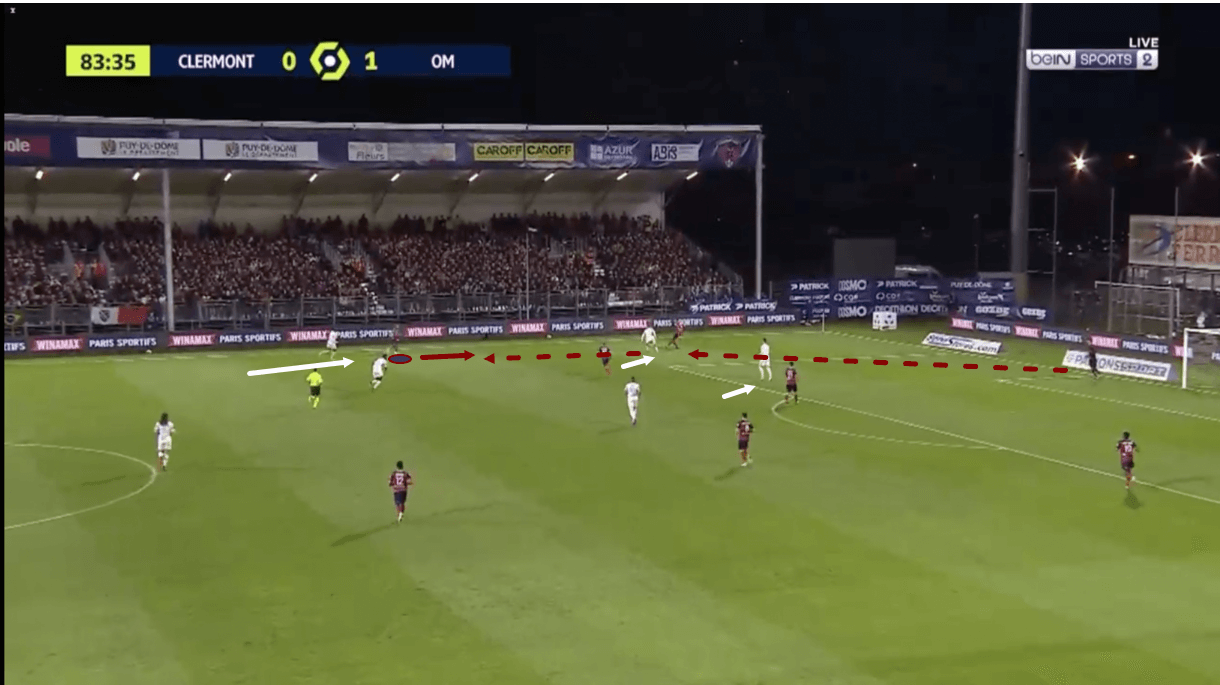
We see an example of this in figure 1. Here, Zedadka is positioned a line ahead of the centre-backs and in the process of dropping deeper to make himself an easier short passing option for the right centre-back who received the ball from Clermont’s ‘keeper just before this image and began attracting intense pressure from an opposition player. Several other opposition players are also getting tight to the right centre-back’s near passing options here, as they deploy a ball-oriented pressing system.
Had Zedadka remained higher here, it’d have been easier for the opposition defender tracking him to mark tightly, while being at a further distance from the ball-carrier would also make him a more difficult passing target. As a result, he decided to move closer to the right centre-back and help his team to try and progress through the opposition’s press via short passes, intricate link-up and intelligent off-the-ball movement like Zedadka’s movement in this example.
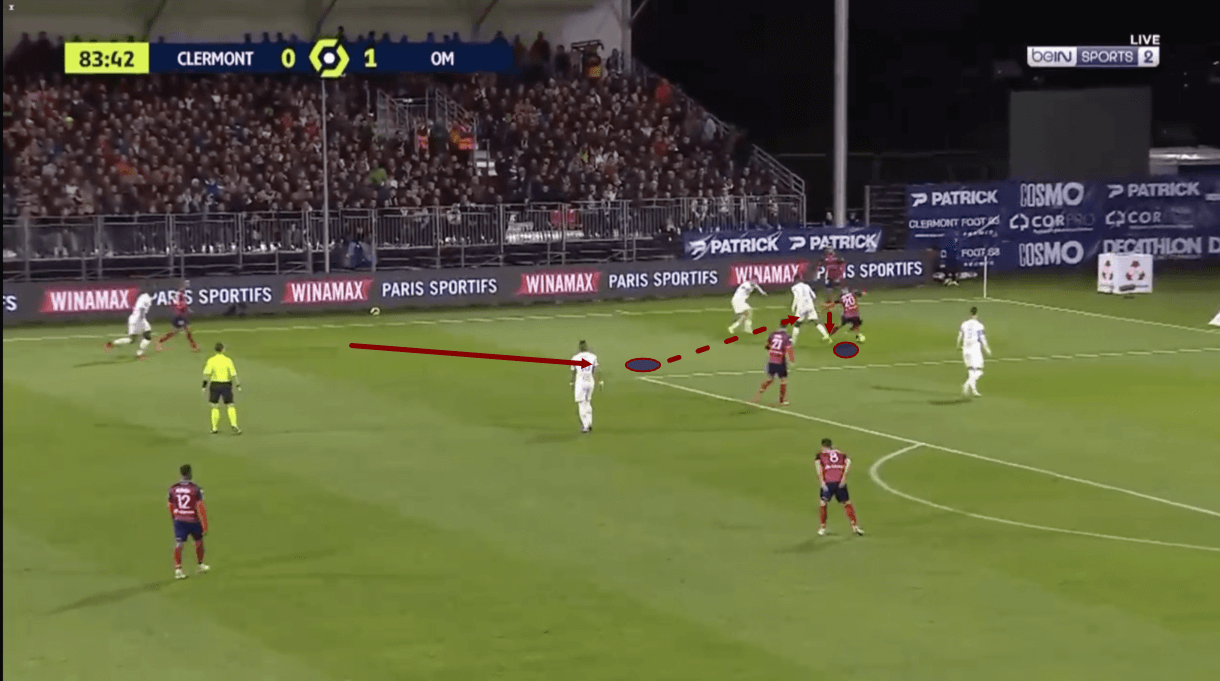
After the right centre-back found Zedadka, the right-back carried the ball slightly more centrally before performing a one-two with the wide centre-back. We see that Zedadka has just received the ball back from the right centre-back in figure 2. At this point, the right-back is under greater pressure from an opposition player who tracked him all the way upfield, while the opposition have committed more men to this side of the pitch to try and regain possession in a dangerous, advanced area of the pitch.
Zedadka remains very calm under pressure, however, which is a key trait of his that makes him an excellent fit for Gastien’s short pass-heavy system. He’s comfortable receiving under pressure, as he did just before figure 2, while he’s also comfortable passing out of pressure while taking his time to get his head up, scan, and assess his passing options.
Just before figure 2, he received the ball from the right centre-back with the inside of his right foot. He carried it towards the wing for a couple of steps, drawing the opposition marker with him, before demonstrating his agility by sticking his left foot out in front, using it as a pivot to balance on and bounce away from, while knocking the ball centrally with the outside of his right foot. We see this in action in figure 2. This highlights some of Zedadka’s physical abilities — his impressive agility and balance, which help him to turn on a dime in situations like this which can be very useful when aiming to lose a marker under pressure, as well as his composure and confidence in this role to play his way out of pressure.
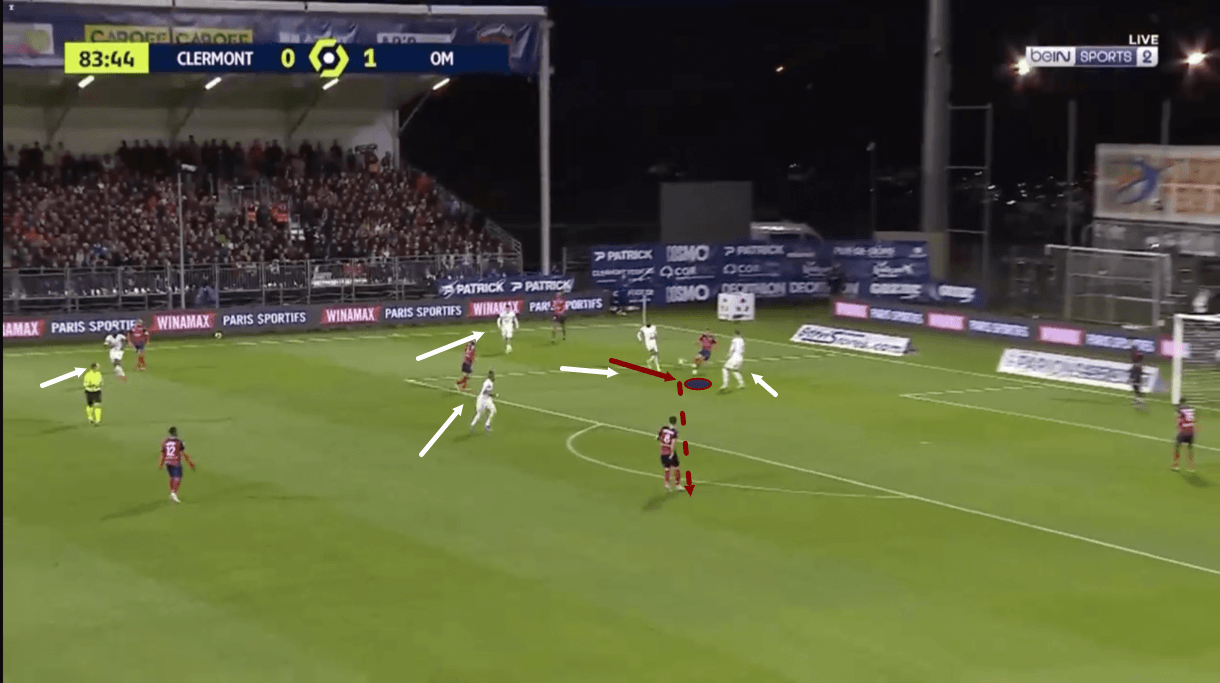
Then, in figure 3, we see that Zedadka’s agility helped him to turn quicker than the opposition marker and find some space. While he attracted pressure from another opposition player in the process of turning and dribbling centrally, he carved out more than enough space and time for himself to get his head up and pick his pass out of pressure. He took the risky decision to play across his box but we see that it paid off as play moves on and he fizzes the ball with pace and accuracy to the free Clermont man on the edge of his penalty box.
This pass helped Les Lanciers to escape from Marseille’s press and exploit the underloaded side of the pitch, with Les Olympiens having committed a lot of bodies to Zedadka’s wing to prevent Clermont from playing out and forcing a high turnover. The right-back played a key part in ensuring that didn’t happen, however, with many of his key on-the-ball skills on display here, including his agility, balance, composure, and good technical passing ability which is aided by his constant diligent scanning — an element of his game that needs to be highlighted.
Zedadka is excellent at getting his head up a lot — before receiving the ball and when on the ball before playing a pass — and quickly processing the information that this scanning feeds to him. He is one of the more diligent players I’ve seen at doing this, which is a key part of any player’s game if they want to be a reliable passer. It improves players’ speed of play and promotes good decision-making, both of which we saw Zedadka display in the previous passage of play. This example was not a one-off — this is a really clear element of Zedadka’s game.
This scanning helps to make his decisions quicker and better but he also needs the technical passing ability to execute his decisions well, which he generally does display, again, as was the case in this example where he found the right foot of the player on the edge of the box (the foot further from the closest opposition player and closer to the ideal area of exit), setting this teammate up to turn quickly and attack the space Marseille left open on the opposite side of the pitch.
So, in terms of short passing ability, link-up play and ability to receive under and play out of pressure, Zedadka passes the test with flying colours and would be an asset to any side looking to build attacks via short passes and intricate play.
He is just human and makes mistakes like anyone — so this is still an area to seek further improvement but, in general, he ranks quite well among Ligue 1 right-backs for passing. He’s played a relatively average number of passes this season for a right-back (42.98 per 90) and he’s managed to retain a solid 84.09% passing accuracy. Don’t expect Zedadka to spray the ball around the pitch and act as something of a quarterback — this isn’t his game at all. He plays very few long passes (2.09 per 90) and hits just over half of them accurately, with many of these long passes being more clearances than a deliberate attempt to play out from the back.
Additionally, Zedadka’s ability to link up with teammates via short passes and play out of pressure as we saw in figures 1-3 is far more impressive than his ability to play more difficult ground passes over a relatively long distance that break opposition lines and find teammates looking to exploit pockets of space further upfield. He’s played 7.92 progressive passes per 90 this season — a decent number that ranks well among Ligue 1 right-backs but not exceptionally well — with a relatively decent success rate of 79.09%. This is an example of an area in which Zedadka performs well enough to have this not be considered a weakness by any means but not well enough to be a standout performer in the league. He is solid in several areas, such as progressive passes, making this a good skill which he can be trusted to perform to a decent standard, but he has far greater strengths.
Ultimately, in terms of progressing upfield, you want Zedadka on the receiving end of progressive passes rather than playing them but, again, if required, he can do the job okay, providing an example of the versatility and well-roundedness that we discussed earlier.
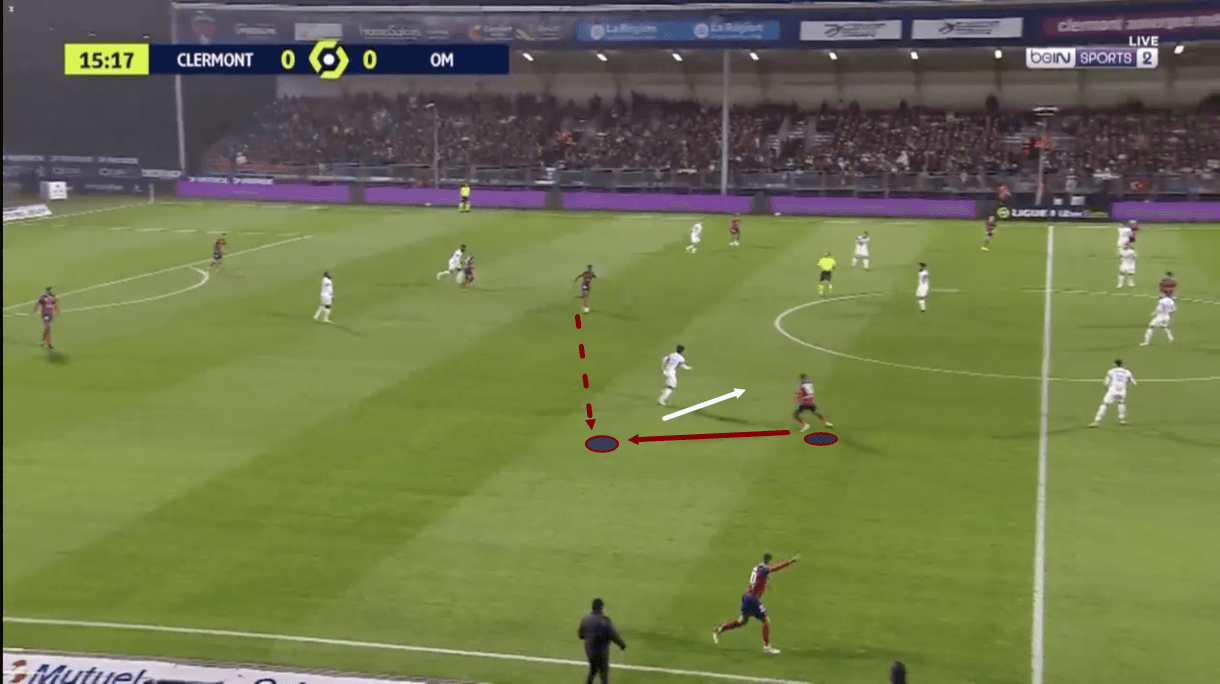
Another positive trait of Zedadka that makes him a good asset for his side when playing out from the back is his willingness to show for the ball — a basic skill but one that he consistently performs to a high level in Ligue 1. Take figure 4 for an example. Here, Clermont’s central midfielder is in possession, facing the opposition half, looking to progress upfield. Meanwhile, Zedadka (highlighted) is occupying a slightly central position, deep in the inside right channel.
With an opposition midfielder just dropping into the passing lane between Zedadka and the central midfielder here, the right-back quickly shifts in the opposite direction, dropping slightly deeper to get out of this Marseille player’s cover shadow and make himself a better passing option for his teammate. As the play moves on, the Clermont midfielder takes up the option of passing to Zedadka and the right-back helps his team to progress into the opposition’s half.
Again, this is a basic part of football — get away from your man, find space, show for the ball, help your teammate by giving him an option — but Zedadka performs it well game in, game out, in France’s top-flight, again highlighting why he’s such a good fit for Gastien’s short pass-heavy system. His off-the-ball movement, scanning and physical effort are always evident on the pitch and this makes him a key man in several phases for Les Lanciers.
Off-the-ball movement
Having touched on off-the-ball movement in the previous section, we’ll shine more of a spotlight particularly on this element of Zedadka’s game in our next section. The 26-year-old is good at making the off-the-ball movements that his teammates require most from him and his role within this system.
Predominantly, Zedadka is required to hold width high on the right-wing, even when his team and the ball are focused more on the left. A prominent part of Clermont Foot’s style of play and strategy is to overload one side of the pitch to attract the opposition block to this side, to prevent Les Lanciers from playing through them too easily. This, then, can result in lots of space being created on the opposite wing and this space can be exploited if Clermont switch the ball from the overloaded side to the underloaded side.
When Clermont overload the left, Zedadka is required to stay high and wide on the right and be ready to exploit space following the switch. Within this role, Zedadka needs to remain alert for when the switch is on and as well as staying high and wide, must time aggressive runs forward into space on the right-wing well to be able to make the most of the space on that wing through his threatening pace.
Of course, as mentioned in the previous section, Zedadka sometimes needs to drop deep to support his teammates, rather than stay high and wide to support them in this more aggressive way, depending on the situation. This is where good decision-making is crucial for him.
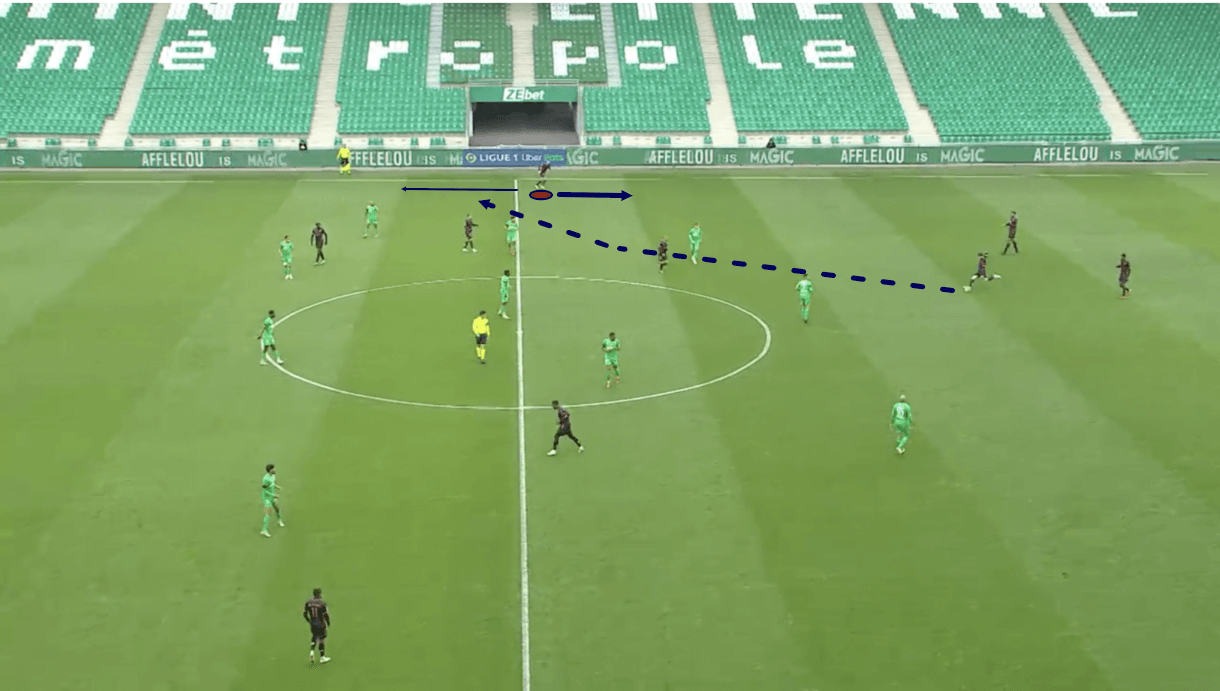
Sometimes, the right-back makes the wrong call. We see an example of this in figure 5, taken from Clermont’s recent Ligue 1 clash with Saint-Étienne. Les Lanciers’ holding midfielder is in possession here, aiming to progress through Saint-Étienne’s disciplined mid-block. The holding midfielder lines up a lofted through ball for Zedadka at the same time as Zedadka opts to drop deep and try to give this player a short passing option deeper in the more traditional right-back position. This moment of miscommunication leads to the ball flying out of play, while it could also lead to a cheap turnover, giving the opposition a good opportunity to counter-attack.
This highlights the importance of Zedadka’s decision-making in terms of his off-the-ball movement and his understanding both with his teammates and their intentions, as well as his familiarity with what Gastien wants from him and his team, in general. A slip up in this area can be critical to progression.
As mentioned at the beginning of this scout report, however, Zedadka has been a prominent figure in Clermont’s side over the last year, playing in the vast majority of their games. His availability and consistent presence in the starting XI helps to make moments of miscommunication and poor positional decision-making few and far between, while it naturally increases his understanding and familiarity both with teammates and Gastien’s strategy.
While slip-ups like this can still occur, as is evident from figure 5, they don’t occur often and Zedadka reliably makes the required movements that help his team the most very often, hence why he’s so trusted to consistently play this important right-back role in Gastien’s system.
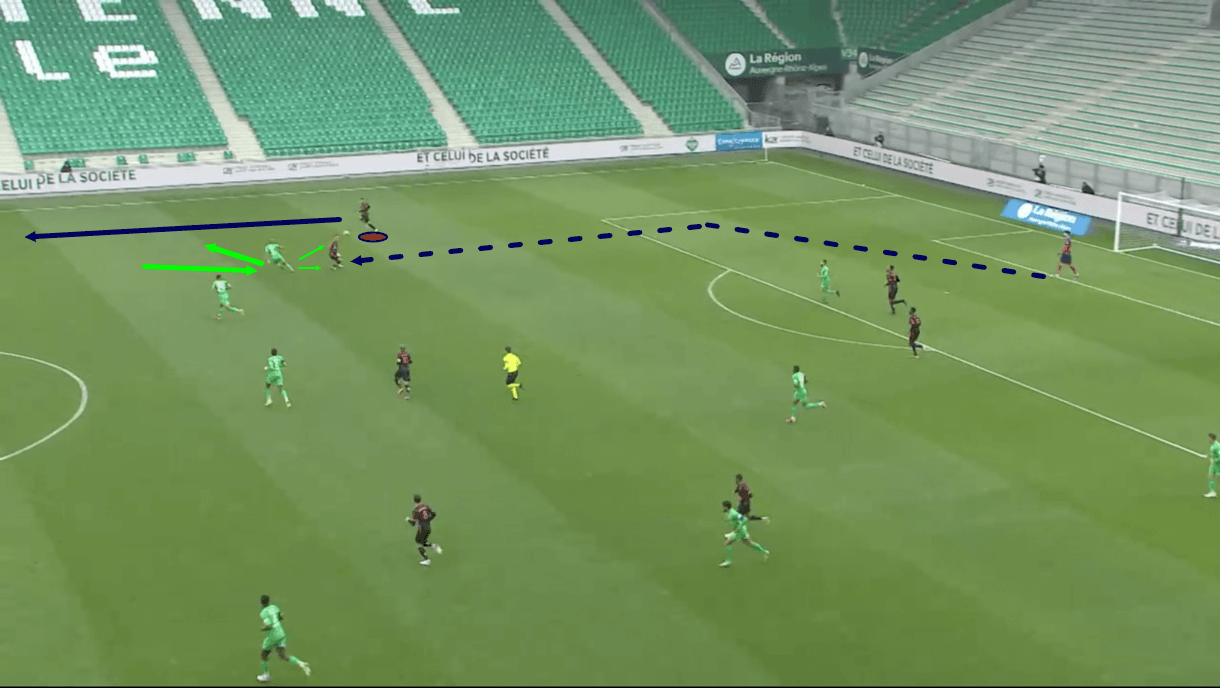
Finding an instance of Zedadka standing still is difficult; he’s a player who likes to constantly be on the move, either making himself a passing option for teammates or creating space for teammates by drawing defenders away from them via intelligent runs. We’ll see an example of the latter in the passage of play we’ll analyse in figures 6 and 7.
Figure 6 shows an example of Clermont playing out from the back. Just before this image, the ‘keeper sent the ball long to the right central midfielder, who can be seen controlling it in figure 6. As he controls the ball, the opposition left-back can be seen pressing him from behind, aiming to prevent him from turning to progress the ball upfield and potentially force a high turnover for Saint-Étienne.
This is where Zedadka’s aggressive forward run proves crucial to the continuation of Clermont’s build-up. In figure 6, the right-back is seen quite deep. This is what allows the opposition left-back to press so high and get so tight to the right central midfielder. At this moment, the Saint-Étienne left-back has nothing to worry about high on Clermont’s right-wing, so he can afford to add an extra body to midfield to stifle Clermont’s build-up. If Zedadka had stayed deep, this could’ve led to a far more successful Saint-Étienne press.
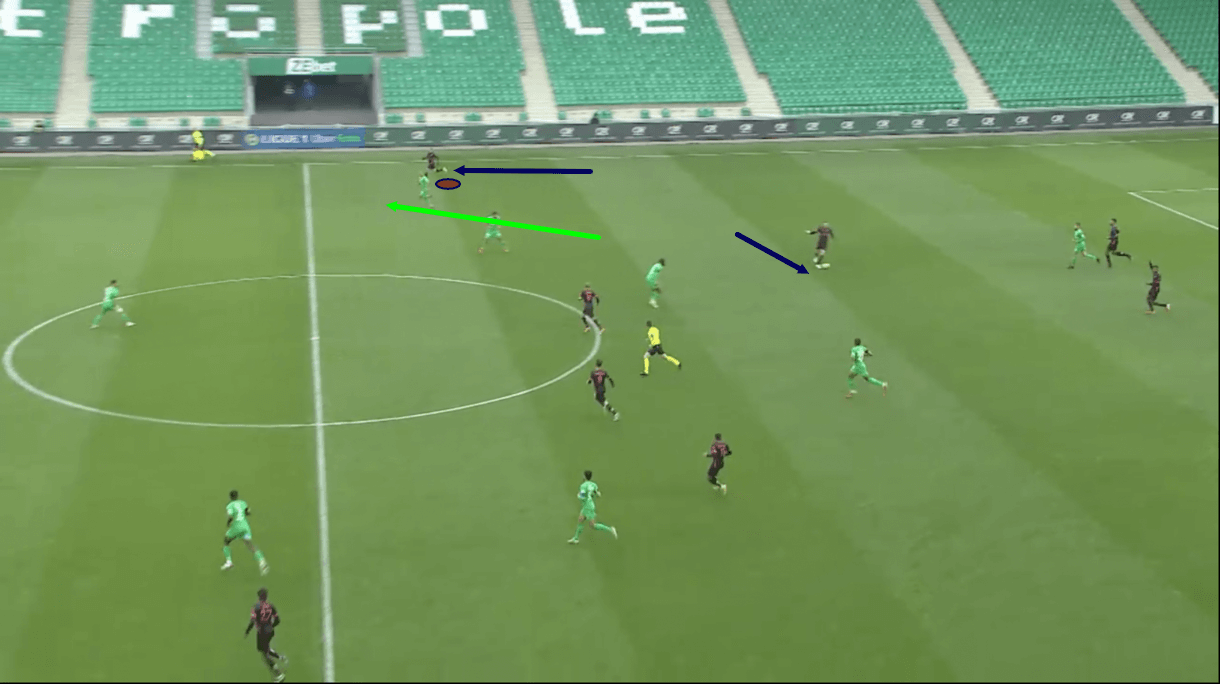
As play moves on into figure 7, though, we see how Zedadka’s quick, aggressive forward run succeeds in attracting the opposition left-back away from the right central midfielder. This creates space for the Clermont midfielder to turn and assess the forward passing options ahead of him, while it also makes Zedadka a viable and potentially dangerous forward passing option, with the right-back speeding away into space on the right-wing here.
The midfielder ultimately opts to send the ball out to the left-wing instead of the right, with the ball-carrier enjoying a lot of space ahead of him to run into towards the left-wing, but regardless of what option the passer chose, this passage of play highlights the key role that Zedadka played in creating space for this player through his intelligent forward run that attracted the left-back away and towards him. This also highlights how Zedadka’s aggressive forward runs can make him an excellent through passing option on the right-wing — a key part of his game, as discussed, as Gastien’s ‘width provider’ in attack on this side.
These skills require good decision-making, spatial awareness, chemistry with teammates, and pace, all of which were on display from Zedadka in this last passage of play.
Crossing
Moving on into the final third and the chance creation phase of play, the most important part of Zedadka’s role is crossing. The 26-year-old doesn’t take a lot of shots, even for a right-back (0.5 per 90), as this isn’t a major requirement from him in his role and his skills are best used in other areas. Meanwhile, though Zedadka does make some dribbles (2.66 per 90, this season), he falls on the lower end of this particular metric when compared with other Ligue 1 right-backs as well, indicating that he’s not among the most frequent dribblers at right-back in France’s top-flight. He does, however, rank well amongst Ligue 1 right-backs for dribbles completed successfully when compared to other right-backs (62.16%).
With the Clermont man generally required to provide the width for his side in the final third, this naturally leads into crossing being a key part of his role, especially as he’s not an incredible dribbler who’s going to weave through multiple defenders to carry the ball into the penalty area. The right-back performs this important part of his role to a high standard and is a very reliable crosser of the ball who’s good at mixing up his crossing technique (some low driven crosses, some high floated crosses to the back post and some medium-height whipped balls across the face of goal) to make his actions somewhat less predictable in the final third, while also very good at executing his chosen type of cross well, with excellent technique.
In this section of analysis, we’ll look more closely at a couple of crosses from Zedadka this term — one low and driven, one high and floated to the far post — that highlight what makes him such a consistently reliable crosser.
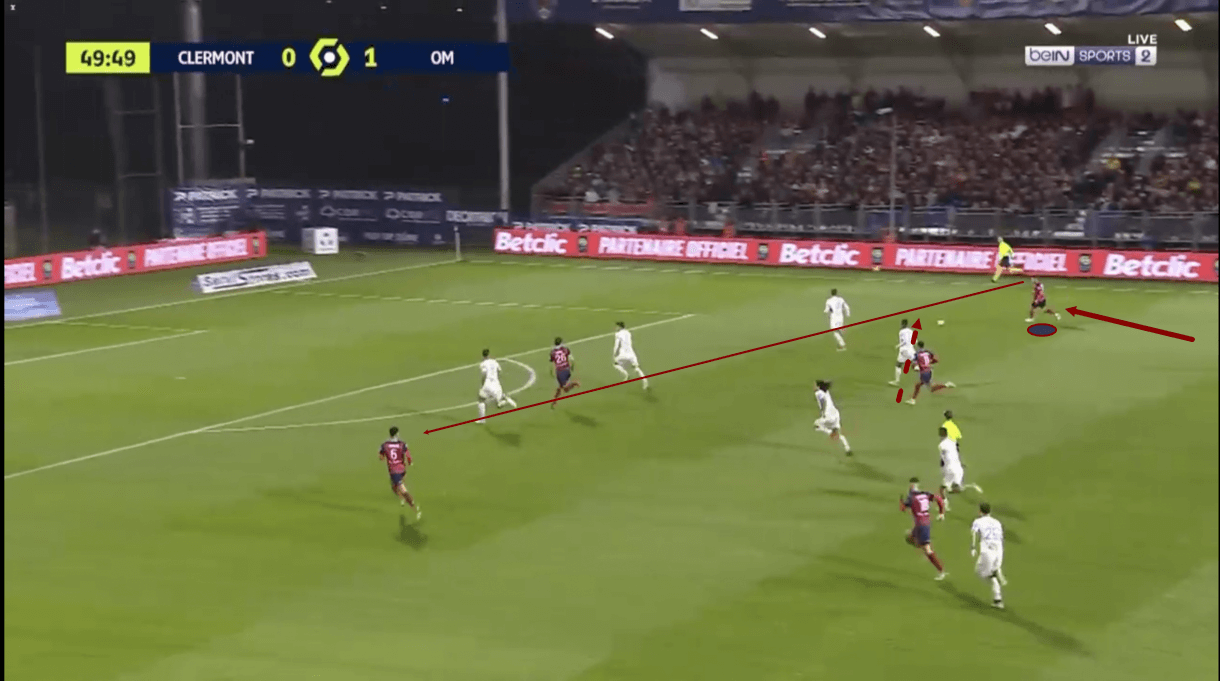
Firstly, figures 8-9 highlight a high ball that Zedadka sent towards the far post when Clermont recently met Marseille in Ligue 1. In figure 8, we see the beginning of Zedadka’s involvement in this move, with the right-back speeding forward from deep, performing the aggressive, arrow-like off-the-ball run into space on the right-wing that has become a staple of his game at Gabriel Montpied Stadium. Whenever his team progresses into the final third, you’ll find Zedadka looking to push forward into space on the right-wing like this.
The wings are key to Clermont’s chance creation under Gastien because, as previously mentioned, this team loves to overload one wing or maybe the centre, attract opposition bodies in, and then switch to the opposite wing or release out wide to exploit space that will have opened up. In this particular example, Clermont built their attack into the final third through the centre of the pitch before releasing to Zedadka who we see bombing forward into space on the right-wing.
Despite making such a quick, aggressive run forward, however, when the right-back approaches the ball here, he doesn’t sprint onto it. He slows down, moving from a sprint to a jog, and — importantly — gets his head up to pick out his target in the penalty box. This is something that, sounds simple and obvious, but a lot of players don’t do when looking to cross the ball. Instead, many players rush onto the ball and look to get it into the box quickly. This can work when performing low driven crosses in or just on the edge of the penalty box but at more of a distance, as was the case here, accuracy is more difficult to achieve and it can be made far easier for the attacker in the box to meet Zedadka’s cross if the crosser takes an extra couple of seconds, gets his head up, and picks out his target more carefully.
Additionally, this effort to scan helps Zedadka’s decision-making. He’ll have a far better idea of how play is developing inside the box, where there is space, and what runs the forwards are making by slowing the game down for a couple of seconds and getting his head up. As mentioned earlier, Zedadka is generally good at processing the information his scanning feeds to him quickly to improve his decision-making. That’s also true for his crossing. While Zedadka hasn’t made an assist this season, and his xA of just 0.79 is fairly average compared with other Ligue 1 right-backs, I rank him as one of the most efficient and dangerous crossers in the league because he’s constantly putting the ball into dangerous positions with precision thanks to a combination of his diligence in scanning and his technical ability to act as a good standard for this level. Should he continue to approach crossing like this and execute his crosses to such a high standard, goal involvements will come.
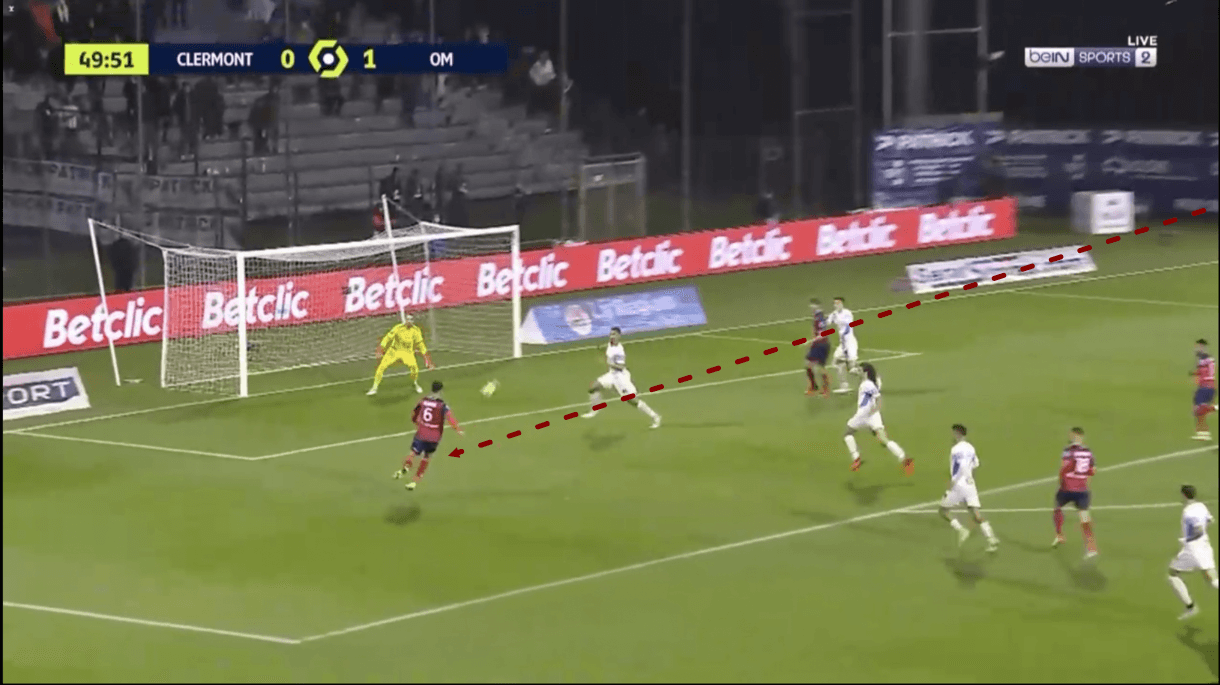
As this passage of play moves on into figure 9, after scanning and picking out his target in the box, Zedadka elegantly floated the ball towards the back post where it landed at the feet of the attacker who was running into the box from the left central midfield position. Zedadka found his target excellently thanks to his intelligent scanning and excellent technical execution of the cross.
This gave the receiver time to assess his next move, as the cross set him up well for a shot or an opportunity to pull the ball back across the box for a teammate in space more centrally. The receiver opted for the latter and as play moves on from here, we see him pull the ball back across goal to set up another teammate in space in an even more threatening position.
This attack only progressed from the right-wing in figure 8 to the far more threatening point at which we see it just a couple of seconds later in figure 9 thanks mainly to Zedadka’s work. This highlights how he can be such a threat on Clermont’s right-wing.
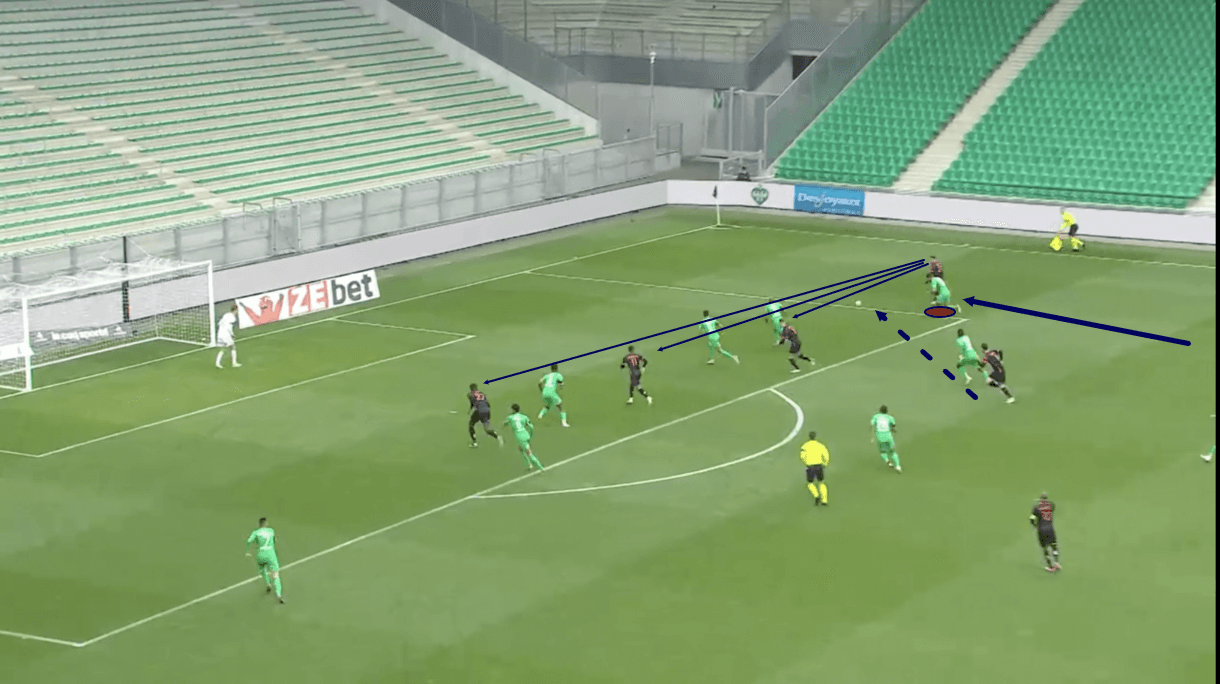
As mentioned previously, though, Zedadka doesn’t just float high balls into the box, he also drives low crosses into the box from more advanced positions closer to goal. We’ll see an example of one such occasion in figures 10-11. Starting with figure 10, again, here we see Zedadka running onto a through ball from the centre and getting his head up to scan and assess his options. This shows how even in more advanced positions under greater pressure, the right-back takes the extra couple of seconds to get his head up and get more information, which can prove crucial to effective chance creation. Through his consistent, diligent scanning in these types of situations, Zedadka provides an excellent example for other right-backs in how to approach crossing.
Here in figure 10, the 26-year-old had three decent options inside the box, all of which would require putting different levels of power and, possibly, height on the ball. This time spent scanning was used to assess those options and choose which one he would pick.
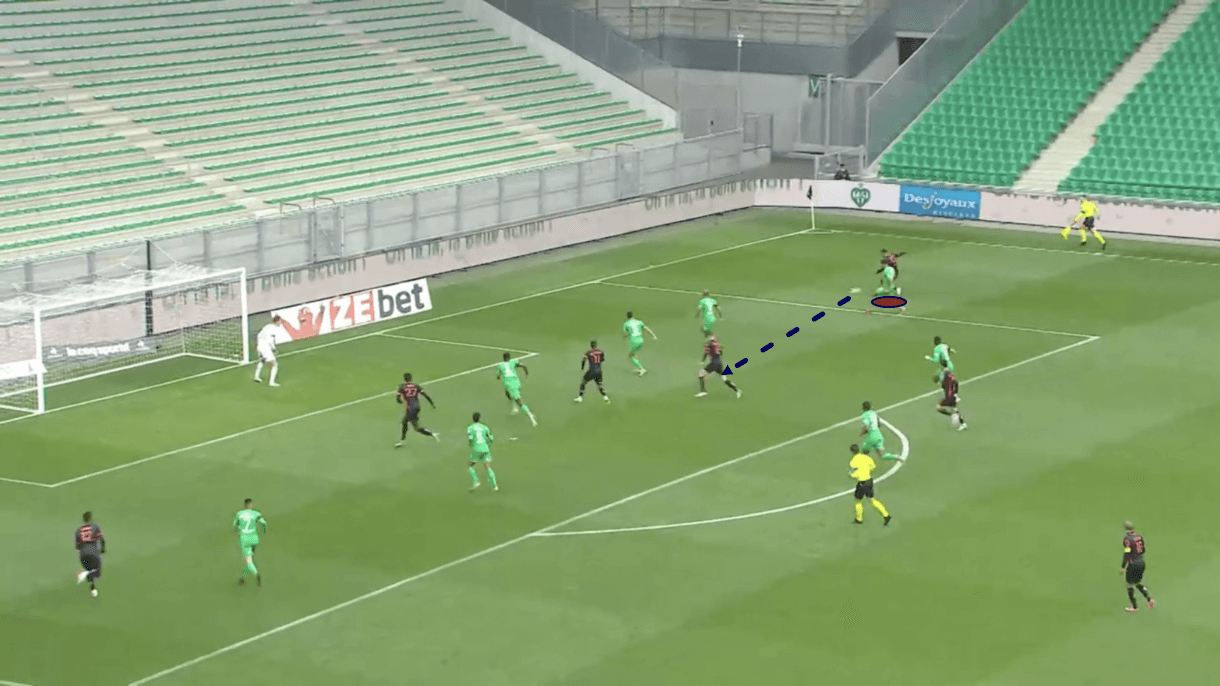
As play moves on into figure 11, we see Zedadka choose to drive the ball into the feet of the nearest attacker. The execution of this cross was slightly off, with the ball flying close to the opposition left-back. However, Zedadka played the ball with so much power that the left-back could do nothing but deflect the ball back into the path of Zedadka’s intended target — the nearest attacker.
Again, this passage of play highlights why I view Zedadka as such an excellent asset inside the final third — off-the-ball movement to get in the right position, scanning to improve his decision-making, and solid execution to help him turn his vision into reality.
Zedadka has played 3.31 crosses per 90 in Ligue 1 this season — a relatively average amount for a right-back in France’s top-flight this term. However, he is one of the most intelligent crossers in the league for taking the time to scan and pick his target in the box. This, combined with his solid technical ability to execute his crosses to a good standard, has led to Zedadka retaining the best cross accuracy rate (52.17%) of any right-back/right wing-back in Ligue 1 this term.
He’s not an incredibly high-volume crosser, he takes his time to assess his options and ensure that he chooses the best possible one to get a teammate on the ball inside the box. This leads to a very impressive cross accuracy rate that highlights his efficiency in the final third.
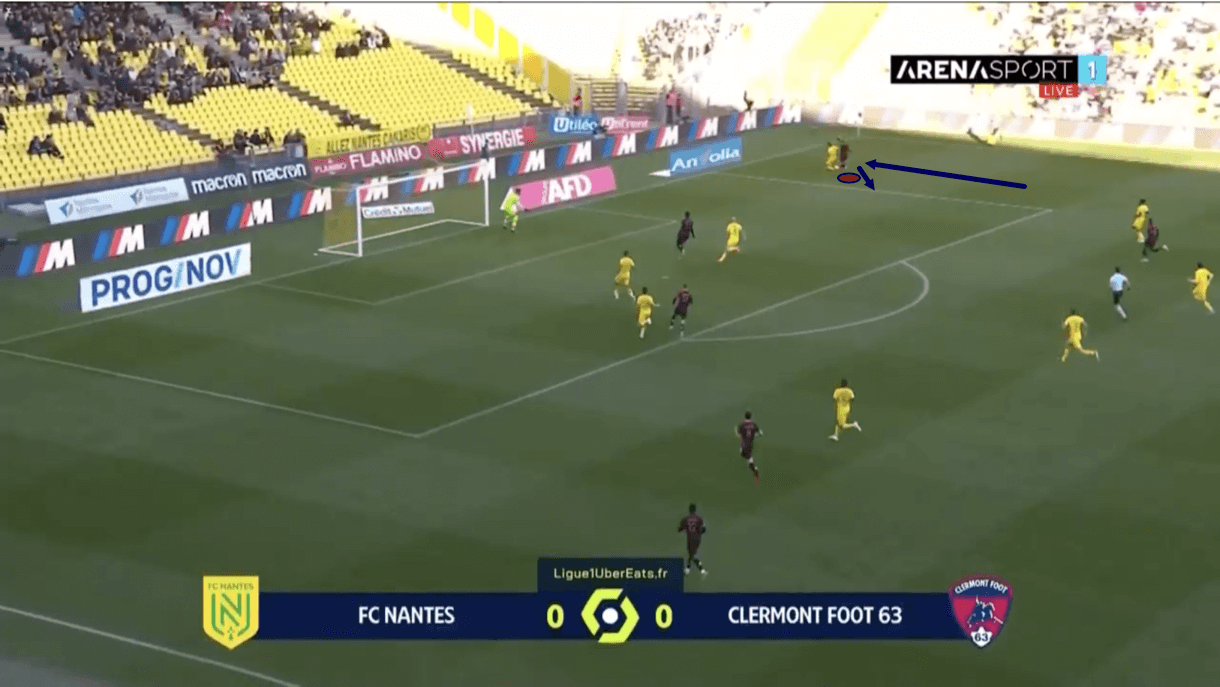
As mentioned earlier, Zedadka isn’t a high volume dribbler and doesn’t ever really aim to weave through multiple opposition defenders to progress into the box — that’s just not his game. However, one particular dribbling move that’s something of a signature to his game is his tendency to drive towards the byline with the ball out on the right wing and lifting back his right foot as he would when performing a low drive cross, before cutting back inside with the ball. We see an example of this in figure 12.
Just before this image, the right-back bombed down the wing towards the byline but instead of driving the ball into the box low and hard, he baited the defender into committing to blocking a low cross before cutting back inside, lightly knocking the ball behind the defender with the inside of his right foot and quickly turning to continue his dribble thanks to his impressive agility.
Again, don’t expect Zedadka to take multiple opposition players out of the game, per match, via his dribbling technique, but do expect to see him perform this intelligent cutback at a relatively high frequency. It’s a simple yet effective move that creates extra time and space for the 26-year-old to assess his options in the box and ultimately create a better crossing opportunity.
Defensive qualities
Our final section of analysis focuses on Zedadka’s defensive qualities — mainly his effective approach to defensive duels, which highlights some of the traits that make him a great all-around asset for his side in defensive phases. Zedadka has completed 10.87 successful defensive actions per 90 this term, which ranks very well among other Ligue 1 right-backs.
He’s made a relatively high 4.54 interceptions per 90, which is yet another testament to his effective and constant scanning, which helps to improve his spatial awareness and defensive positioning. This sees Zedadka pick up good positions near to but not on top of opposition attackers aiming to receive forward passes in dangerous positions. He’s excellent at reacting well to these passes being played — highlighting his alertness — and cutting off the passing lane via his quick acceleration.
The Clermont man has also engaged in a relatively low 1.87 aerial duels per 90 this season, winning a fairly average 42.31% of them. Standing at 173cm, Zedadka isn’t a very imposing physical presence. He can be beaten in the air by a bigger player. However, many opposition wide men won’t tower over Zedadka and, in general, he tends to approach aerial duels well, positioning himself close to the opposition attacker and trying to unbalance them and stifle their jump through his physicality. Additionally, Zedadka typically displays a good jumping reach when approaching aerial duels with a run-up, which helps him to come out on top against players of similar stature. Again, versus noticeably bigger players, aerial duels are still a notable weakness in his game that would be intelligent to target for opposition teams, because, as we’ll go on to discuss, Zedadka tends to fare far better in ground duels.
The 26-year-old tends to simply perform his defensive duties well by performing the basics to a good standard. He’s good at driving attackers away from goal and preventing them from backing into him by taking a side-on body shape and using his strength to hold his ground and move forward, while in ground duels, he tends to perform very well by remaining patient, keeping an appropriate distance between himself and the attacker, and taking a side-on body shape to be prepared to turn, if necessary.
All of this has helped Zedadka to win an impressive 63.41% of his 8.87 defensive duels per 90 (ranking him 8th among Ligue 1 right-backs/right wing-backs/right midfielders) this season. In this section of analysis, we’ll look at a couple of examples highlighting what makes Zedadka so effective in defensive duels.
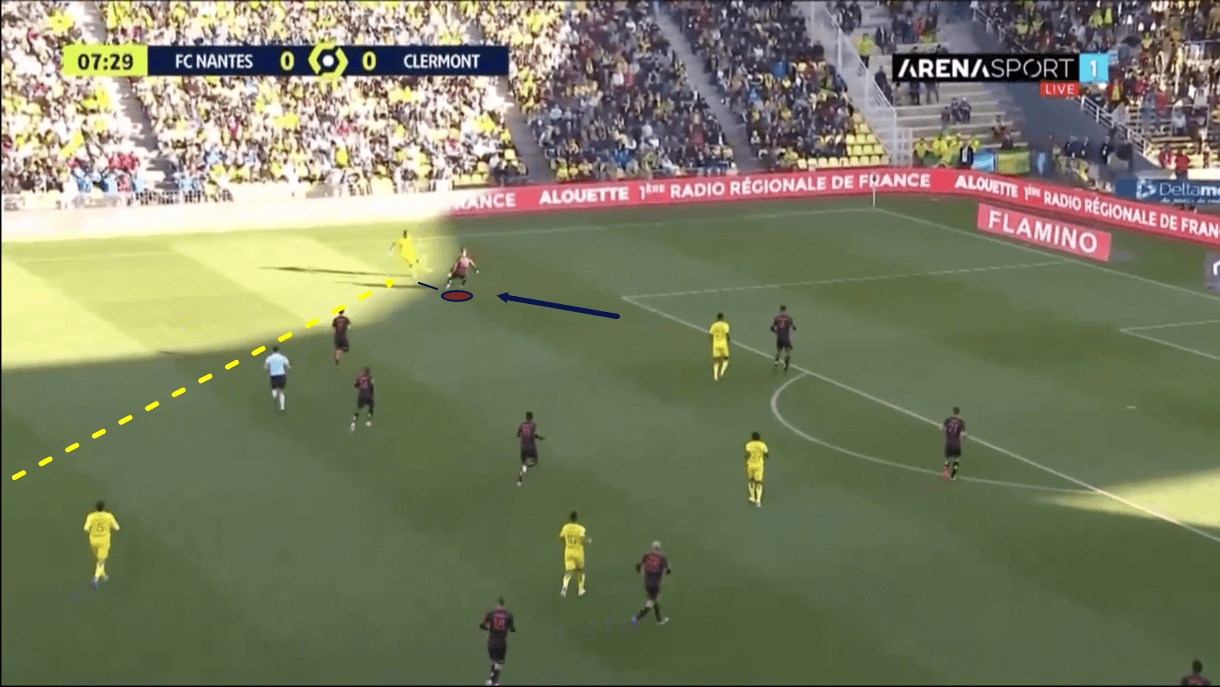
Firstly, figure 13 shows an example of Zedadka engaging an opposition winger who’s just received the ball out wide. When the ball moves out wide, with Clermont dropped into a low-block at this point, Zedadka is required to step out and confront the attacker, with the right-winger remaining centrally to keep this area of the pitch congested. This allows a lot of space behind Zedadka to open up and emphasizes the right-back’s responsibility to win this defensive duel.
He manages to do so by performing those basic defensive skills mentioned earlier to a high standard. After rushing out to approach the attacker, Zedadka halts in an instant, which forces his feet square for just a moment, as we see in figure 13. However, the attacker is just controlling the ball at this moment and Zedadka uses this time to reposition himself, which he’s in the process of doing in this example.
The right-back opts to stop at this point, rather than rushing into committing a defensive action and potentially allowing the attacker to use his overeagerness against him by dribbling past, to keep an appropriate distance between himself and the winger. He doesn’t want to get too close and make himself too easy for the attacker to beat 1v1, while he also doesn’t want to stay too far and give the attacker too much time and space to simply pick out a pass/cross — Zedadka is sometimes guilty of the latter, however, and does need to work on better identifying occasions when he’s giving the attacker too much space. However, his reluctance to get too close does protect the space behind him better and prevents attackers from dribbling past him too easily; this is something we very rarely see, with Zedadka.
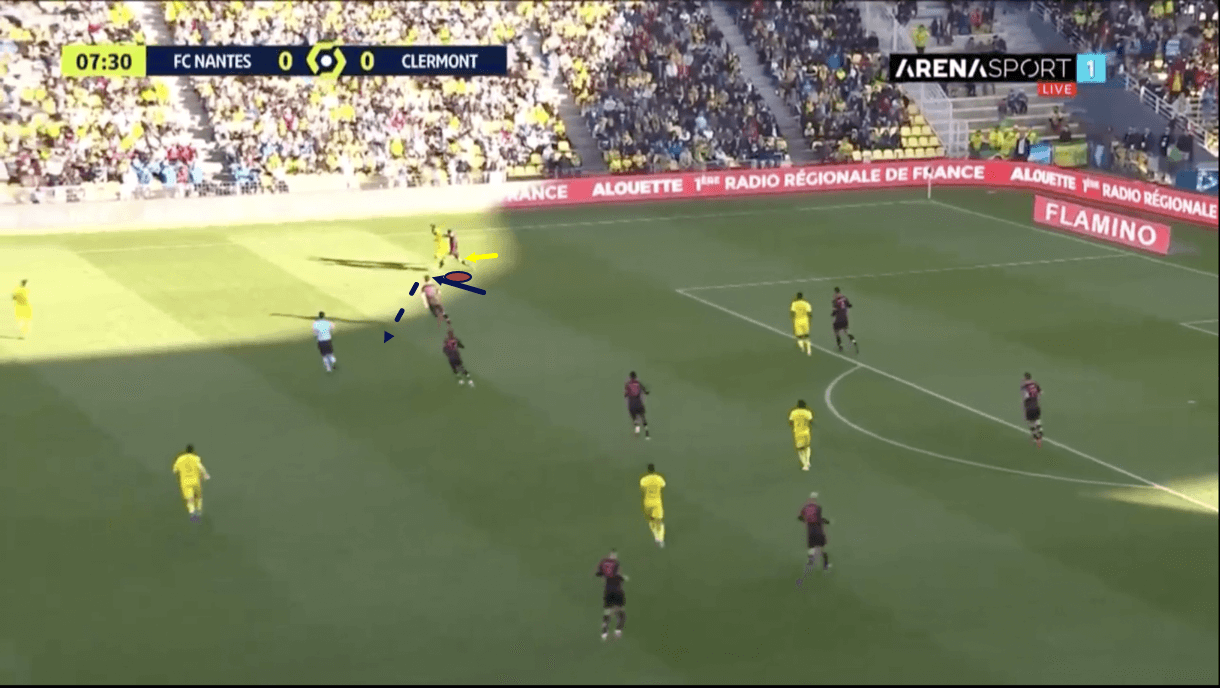
As this passage of play moves on into figure 14, we see that thanks to Zedadka’s aggressive forward movement and good body positioning, the opposition attacker was forced into a negative, backwards touch. The right-back took this as a pressing trigger, with the winger now facing away from Clermont’s goal and presenting less of a threat to the open space behind him, and sprung into action, closing the distance between the two men quickly and beginning to challenge for the ball, shoulder-to-shoulder.
As we see here, there are certain pressing triggers Zedadka will use to make his move and close in on the attacker — one being a backwards touch, as we saw here. Zedadka will also use heavy touches or attempts to dribble past him as triggers to increase his pressing intensity and try to regain possession. The key thing here for the right-back is to try to force the attacker to make the first move and potentially make themselves vulnerable. Zedadka doesn’t want to enter into a 50/50, he wants to enter defensive duels in which he has the advantage, with the opposition attacker making the riskier first move. This is what happened in figure 14 and as play moves on from here, we see the right-back insert himself between the man and the ball, overpowering the winger physically to win back possession for Clermont.
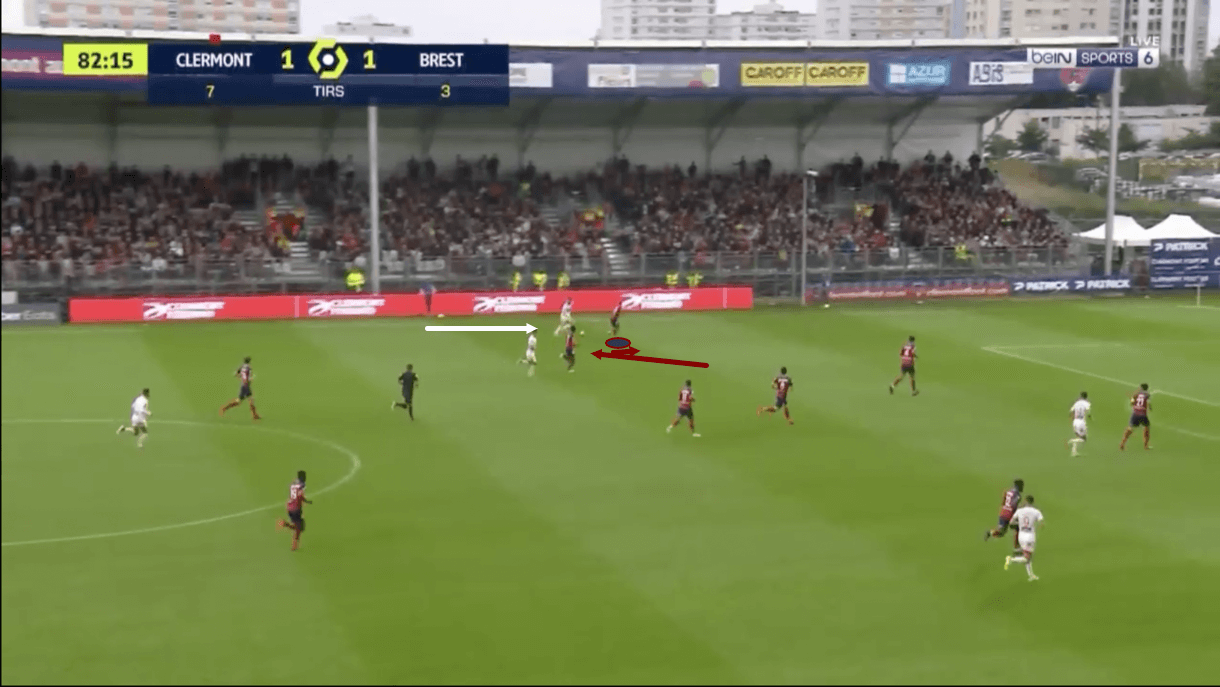
We see an example of a similar situation to figure 13, here in figure 15. Just before this image, the opposition wide man received the ball out wide and began carrying it forward, attracting attention from the Clermont right-back. Again, Zedadka is drawn out of the backline here, as opposed to the right-winger confronting the attacker, for the same reasons and with the same potential consequences as discussed when analysing the previous example.
This image provides an excellent example of Zedadka’s side-on body shape. While he’ll face forward when running out of the backline, he’ll move into this body shape when he reaches his destination and feels he’s at a good distance from the attacker. This is the best possible body shape that the right-back could take up in this situation. It shows the winger away from the centre and down the wing, which means leaving a less threatening area open to protect a more threatening area, while it also means that Zedadka won’t be caught flat-footed and square. He’s on his toes, turned sideways and ready to react to the attacker’s next move, whether that’s turning backwards, knocking the ball down the wing, or trying to get around Zedadka.
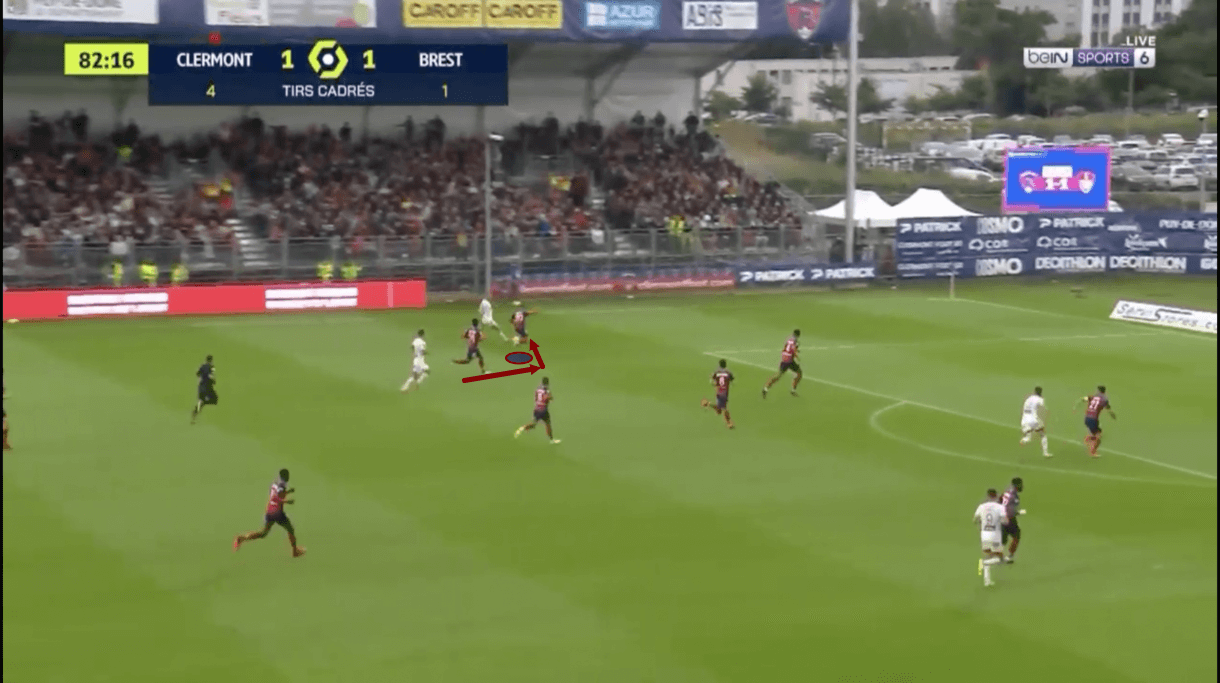
As play moves on into figure 16, we see that the attacker opted to knock the ball down the wing to try and forge a crossing opportunity for himself, using the space Zedadka’s leaving open on the wing and between the two men to try and create something. However, the benefits of Zedadka’s intelligent distancing and side-on body shape are evident, as he’s able to quickly react to the attacker’s movement, turn in an instant, and move in before the wide man can execute his cross.
Zedadka opts to perform a sliding tackle here, which is something he’s not afraid of. He’s made 0.72 slide tackles per 90 this season, which is relatively high among Ligue 1 right-backs. However, he doesn’t just dive into these tackles, they’re generally performed similarly to this one, having managed his distance to the attacker well, forcing them into making the first move, and creating an advantageous situation for himself.
Zedadka isn’t overly aggressive with his sliding tackles or his defending, in general. He’s calm, composed, and calculated in defensive phases. This has helped him to generate an excellent defensive duel success rate while making just 0.72 fouls per 90 — relatively low among Ligue 1 right-backs, which is a testament to his solid defensive technique.
Conclusion
To conclude this scout report, I feel Zedadka deserves a mention as one of the most well-rounded right-backs you’re going to find. The 26-year-old performs his role excellently going forward in all possession phases, as we’ve analysed here, in addition to performing his role without the ball to a high standard and boasting really impressive defensive numbers.
While his offensive numbers aren’t always so impressive, in terms of goal involvements particularly, this doesn’t reflect his true level of threat and excellent offensive efficiency. Zedadka’s not just a solid defensive right-back, he’s a creative threat in the final third and a great option for a short pass-heavy side in build-up who suits Gastien’s system down to the ground.
Like any player, he has some weaknesses, of course, as mentioned in this tactical analysis piece, but I rate him very highly as a player who offers almost everything you’d essentially require from a modern right-back.

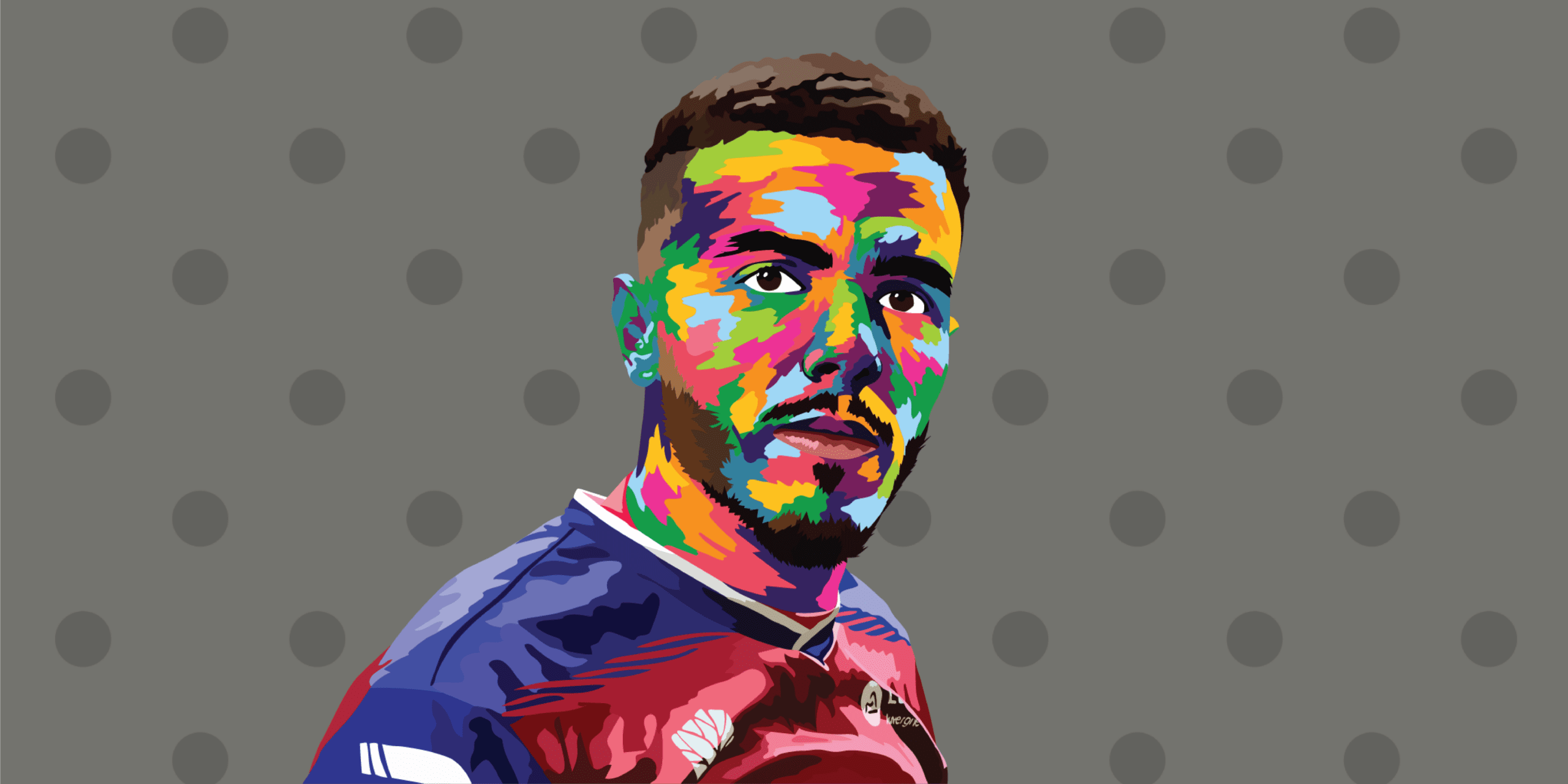


Comments